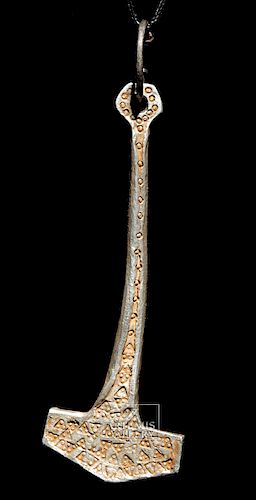Massive Viking Silver Thor's Hammer, 57.8 g
Lot 87c
About Seller
Artemis Fine Arts
686 S Taylor Ave, Ste 106
Louisville, CO 80027
United States
Selling antiquities, ancient and ethnographic art online since 1993, Artemis Gallery specializes in Classical Antiquities (Egyptian, Greek, Roman, Near Eastern), Asian, Pre-Columbian, African / Tribal / Oceanographic art. Our extensive inventory includes pottery, stone, metal, wood, glass and textil...Read more
Estimate:
$6,000 - $9,000
Absentee vs Live bid
Two ways to bid:
- Leave a max absentee bid and the platform will bid on your behalf up to your maximum bid during the live auction.
- Bid live during the auction and your bids will be submitted real-time to the auctioneer.
Bid Increments
| Price | Bid Increment |
|---|---|
| $0 | $25 |
| $300 | $50 |
| $1,000 | $100 |
| $2,000 | $250 |
| $5,000 | $500 |
| $10,000 | $1,000 |
| $20,000 | $2,500 |
| $50,000 | $5,000 |
| $100,000 | $10,000 |
| $200,000 | $20,000 |
About Auction
By Artemis Fine Arts
Feb 21, 2019
Set Reminder
2019-02-21 10:00:00
2019-02-21 10:00:00
America/New_York
Bidsquare
Bidsquare : Exceptional Antiquities, Asian, Ethnographic
https://www.bidsquare.com/auctions/artemis-gallery/exceptional-antiquities-asian-ethnographic-3858
An important one-day auction featuring museum-worthy examples of Egyptian, Greek, Roman, Etruscan, Near Eastern, Far East / Asian, Pre-Columbian, African / Tribal, Oceanic, Native American, Spanish Colonial, Russian, Fossils, Ancient Jewelry, Fine Art, so much more! Artemis Fine Arts info@artemisfinearts.com
An important one-day auction featuring museum-worthy examples of Egyptian, Greek, Roman, Etruscan, Near Eastern, Far East / Asian, Pre-Columbian, African / Tribal, Oceanic, Native American, Spanish Colonial, Russian, Fossils, Ancient Jewelry, Fine Art, so much more! Artemis Fine Arts info@artemisfinearts.com
- Lot Description
Northern Europe, Viking or Norse culture, ca. 8th to 11th century CE. A stunningly beautiful pendant of a massive size, crafted from high-grade (95%) silver, in the form of Mjolnir, the legendary hammer of the lightning god Thor. The hammer has a slender handle decorated with stamped circles along the top half and surrounding both faces of the integral suspension loop. Dense motifs of stamped triangles containing a trio of raised dots cover both sides of the roughly-rectangular hammer head which droops to a wide point along the bottom edge. Viking men and women would wear accessories like this example as a sign of religious belief and visual wealth. They were often times used as currency or deposited in rivers as offerings to the gods, though they were also buried with their owners upon death. With its wrapped wire ring, this is an incredibly rare and wearable example of fine Viking artistry! Size: 1.75" W x 4.875" H (4.4 cm x 12.4 cm); quality of silver: 95%; total weight: 57.8 grams.
Small Thor's hammers were worn as religious amulets throughout the Viking era, usually made of silver and usually hung on silver chains. Some even made it to the Christian era; there is a famous example of a Thor's hammer amulet from Fossi, Iceland, that has been turned into a cross. The chain itself, meanwhile, is a style of knitwork done with thin silver wire that seems to have originated with the Vikings. The important Viking metalworking shops correspond to their great trading ports and proto-urban centers - Birka, Helgo, Sigtuna, and Lund in Sweden, Ribe, Haithabu (Hedeby), and Fyrkat in Denmark, and Kaupang and Trondheim in Norway.
Silver was the principal currency of the Viking world, which stretched from Russia to northern Canada at the height of their influence. In many places, the Vikings kept silver not as coins, but as jewelry, a wearable currency form that was not subject to the authority of a monarch or mint. One of the most common archaeological finds from the Viking period is a hoard of metal objects, often buried in the earth or deposited in bodies of water, like river beds. These are found in great quantities throughout the British Isles and the Nordic countries.
A much smaller example of a Mjolnir pendant hammered for $37,500 at Christie's, New York "Ancient Jewelry" auction (sale 2771, December 13, 2013, lot 349): https://www.christies.com/lotfinder/ancient-art-antiquities/a-viking-silver-pendant-circa-10th-early-11th-5753593-details.aspx?from=searchresults&intObjectID=5753593&sid=77169efc-dac8-4fc5-a783-8af9965ca7a1
Provenance: private East Coast, USA collection; ex-Neil Phillips collection, New York, USA, acquired in the 1980s
All items legal to buy/sell under U.S. Statute covering cultural patrimony Code 2600, CHAPTER 14, and are guaranteed to be as described or your money back.
A Certificate of Authenticity will accompany all winning bids.
We ship worldwide and handle all shipping in-house for your convenience.
#143856Slight bending to handle, head, and overall form, with light encrustations within some stamped decorations, and minor abrasions, otherwise intact and excellent. Light earthen deposits and great patina throughout.Condition
- Shipping Info
-
All shipping is handled in-house for your convenience. Your invoice from Artemis Gallery will include shipping calculation instructions. If in doubt, please inquire BEFORE bidding for estimated shipping costs for individual items.
-
- Buyer's Premium



 EUR
EUR CAD
CAD AUD
AUD GBP
GBP MXN
MXN HKD
HKD CNY
CNY MYR
MYR SEK
SEK SGD
SGD CHF
CHF THB
THB












